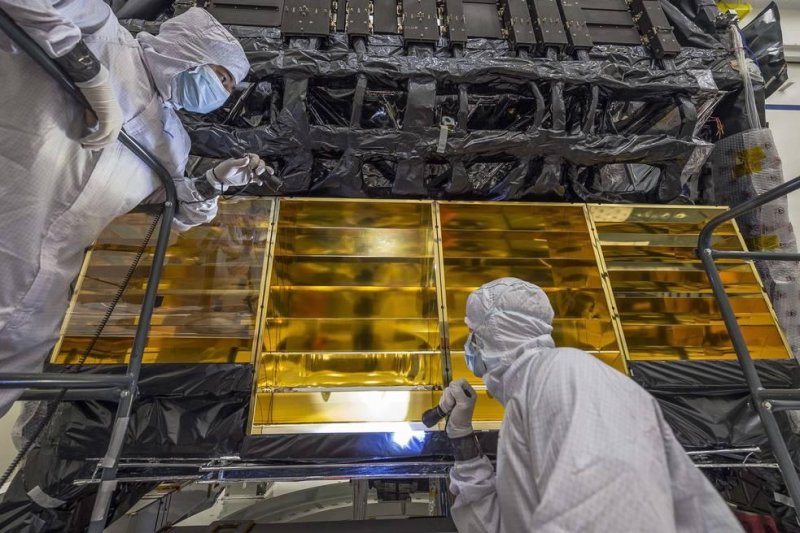NASA engineers are seen installing gold baffling on the James Webb Telescope. The baffles will help redirect excess heat away from the telescope's instrumentation. Photo by NASA/Chris Gunn
June 5 (UPI) -- Engineers at NASA have found a way to redirect excess heat from the James Webb Telescope's most sensitive instruments.
The telescope's four instruments are contained within the integrated science instrument module, or ISIM, which sits behind the array's main mirror. These sensitive instruments could be damaged or disrupted by excess heat, so scientists had to find a way to redirect thermal energy away from the ISIM.
As detailed in a mission update published Tuesday by NASA, engineers are currently installing gold baffles that will channel thermal radiation away from the instruments and out into space. Gold also helps the telescope's mirrors direct infrared light toward the ISIM.
"Gold has a very high reflectivity in the infrared spectrum range, so it is ideal for directing heat," said Matthew Stephens, a mechanical systems engineer for Webb at NASA's Goddard Space Flight Center. "This is the same reason all of the primary, secondary, and tertiary mirrors are gold-coated."
Over the last year, scientists and engineers at NASA have been testing the telescope's mirrors to ensure they are perfectly aligned, can properly unfold upon deployment and are able to withstand the changes in heat and pressure that occur during space travel.
One round of testing saw the mirrors blasted with earsplitting noise, while another round subjected the mirrors to an array of vibrations to test their stability.
During these tests, the gold baffles have been stored away in protective seals to prevent contamination. Now, scientists are reinstalling the baffles, but they will remain sealed during additional rounds of testing.
NASA has delayed the launch of the telescope several times, as the mission's design, construction and testing phases have taken longer than originally anticipated. The telescope is currently scheduled to be carried into space in May of 2020.
Anticipation remains high.
Astronomers expect the rich astronomical data returned by the James Webb Space Telescope to be well worth the wait.
The telescope's 18 hexagonal mirrors will field massive amounts of infrared light, allowing scientists to peer deeper into space with greater clarity and to study the universe's first generation of stars and galaxies. The James Webb Observatory will also help scientists study the habitability of nearby exoplanets.















